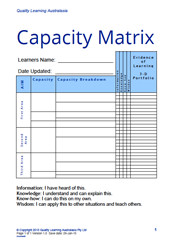
A Capacity Matrix is a tool to describe document and monitor our learning. It allows us to clearly identify what is it we wish to learn derived from the curriculum and student interests and then track learning over time. It can be very effectively used with the Plan Do Study Act (PDSA) cycle and supported with a portfolio that provides evidence of our learning. Capacity Matrices are also used for self-assessment as well as peer assessment. An example of a Capacity Matrix for Year 5 Number and Place Value prepared by Tim Holness from Namadgi School ACT.
Related resources

Capacity Matrix Guide (pdf)
Use the Capacity Matrix to help you and your students understand the curriculum. The Capacity Matrix guide explains HOW TO use the powerful Capacity Matrix. Empower your students to set meaningful learning goals plan self-assess and monitor their learning progress.

Capacity Matrix Template (MS Excel)
This Capacity Matrix template helps teacher and learner to document the capacities to be developed by the learner. It enables the depth of learning to be monitored against each capacity. Students understand what is to be learned (the curriculum) and to monitor their learning progress.

Capacity Matrix Template (MS Word, portrait)
This Capacity Matrix template helps teacher and learner to document the capacities to be developed by the learner. It enables the depth of learning to be monitored against each capacity. Students understand what is to be learned (the curriculum) and to monitor their learning progress.

Capacity Matrix Template (MS Word, landscape)
This Capacity Matrix template helps teacher and learner to document the capacities to be developed by the learner. It enables the depth of learning to be monitored against each capacity. Students understand what is to be learned (the curriculum) and to monitor their learning progress.
Most resources on this website are free. For some resources, such as this, we require you to register so that we may keep you informed of Quality Learning news and new resources. Should you choose, you will be able to opt out of our communications at any time.




